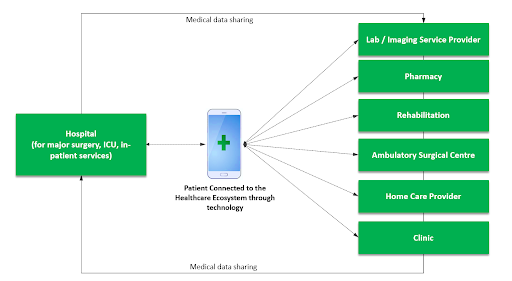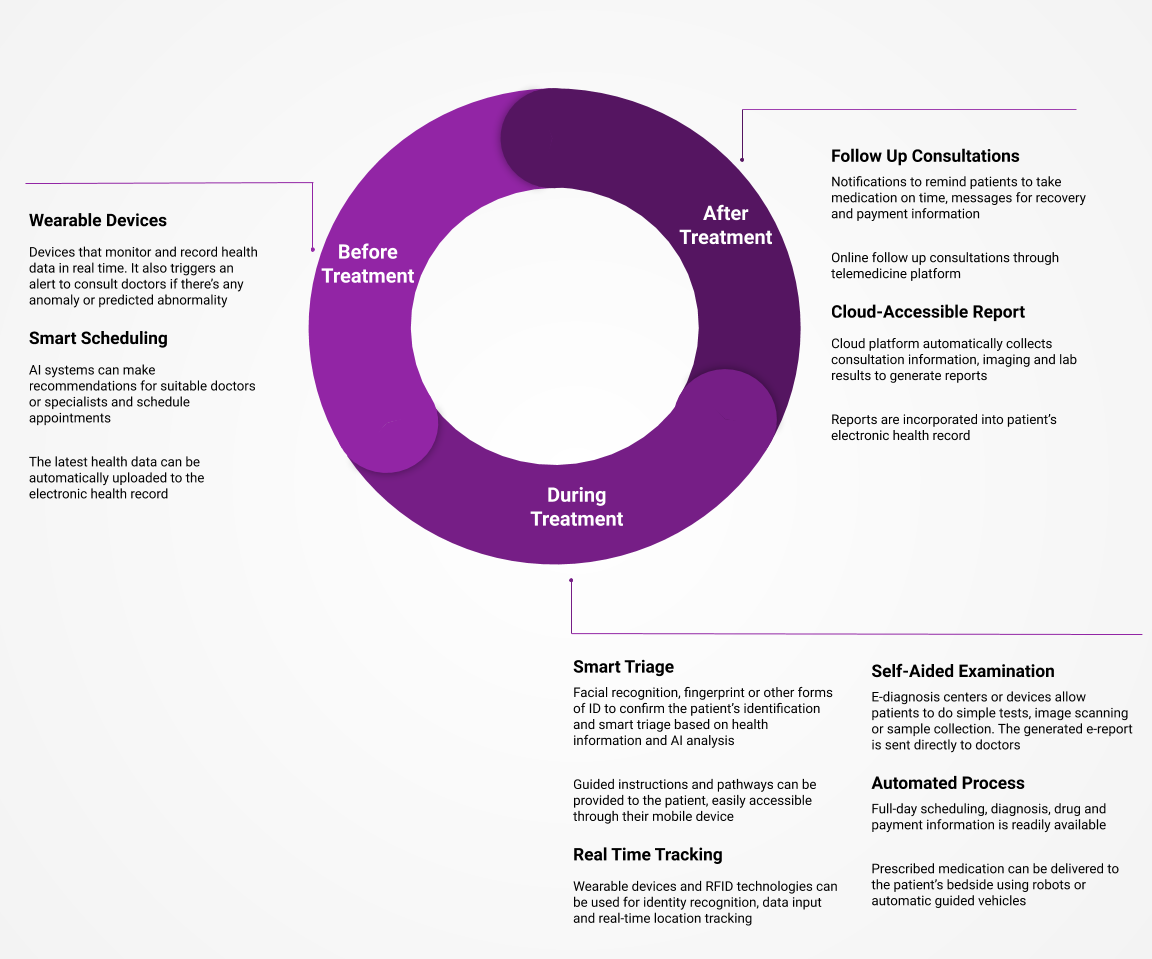Technology has revolutionized so many aspects of our lives, the digital transformation of healthcare delivery and Asia’s smart hospital is no exception. The growing technology has altered the expectations we have, and even filling up a paper form can feel dated.
The adoption of new technologies is driven by various factors in order to optimize efficiency, control costs, and to make full use of technology for greater precision and outcomes, reducing the error rate.
Furthermore, customers have grown accustomed to technological advancements in many areas of their life, and they expect the healthcare industry to follow suit. Healthcare is considered a necessity but hospitals are businesses after all, and with all businesses, no customers = no profit. The digital transformation of Asia’s smart hospitals is inevitable and necessary.
This article is the first of our series focusing on digital healthcare. In this article, we’ll look at the core characteristics of a smart hospital and what digital healthcare looks like. Up next in the series, we’ll look into:
- Digital Patient Experience Trends for 2021
- Keys to Successful Digital Transformation in Healthcare
- What is Digital Healthcare UX?
Core Characteristics of Smart Hospitals
Digital healthcare isn’t designed to provide all the services under a single entity as a smart hospital, instead it’s streamlined to a narrower set containing high-value services in an ecosystem.
The future ecosystem houses various entities of healthcare that is decentralized and patient-centric where data and information is shared across the entities:

Image 1
In the ecosystem, each entity plays their own role. For example, at patients’ homes, their gym and clinics, the focus is on healthcare management and preventative programs. Whereas ambulatory centers take charge of medical treatments and minor procedures and smart hospitals would be responsible for major surgeries and treatments.
The information sharing within the ecosystem results in a convenient and effective healthcare service, improving the service quality because the roles and responsibilities are clear, whilst lowering the costs. Patients’ health records are secured and shared accordingly, allowing better disease prevention, better quality of acute care and long term chronic disease management.
Key features of digital healthcare:
Digital Connection
Smart hospitals are an integral part of the interconnected ecosystem, as we can see in image 1 above. The digital connection to share data amongst the entities is vital in providing efficient and high-quality healthcare.
Personal digital health records function as the foundation for the information system, where primary care providers and the independent entities all contribute to a single healthcare record for each patient.
The digital connectivity can also enable real-time data sharing between the hospitals and third-party entities such as claims or payment data if legally permissible for more effective insurance claims process.
Of course, with respect to data, all the respective entities must adhere to the standard and structure of the data with regards to how the data is collected, stored, transmitted and used. These rules must be in place in order to keep the data safe for appropriate use, ensuring the protection of patient privacy.
Furthermore, the digital connection isn’t restricted to the entities. With wearable technology and other interactive equipment, it enables real-time data collection, tracking and transmission. Clinical staff members won’t need to go back and forth for patient records but instead can access important data through mobile devices for efficient clinical operations.
The digital connectivity is useful and crucial for hospitals to fully understand in detail what happened before the patient was admitted to provide the most suitable inpatient care and to even manage post-discharge interventions.
Vietnam is making use of digital connection to create a smart medical operation center which continually updates information across 47 hospitals in Ho Chi Minh City to keep track of their occupancy rate and Covid-19 patients.
In addition, the digital connection is further utilised in updating the city health officials on the progress for them to continue monitoring the situation, and to contact new patients and frontliners.
High Degree of Automation
Traditional hospital care is very labour intensive whereas smart hospitals rely on automation which significantly increases the efficiency, accuracy and productivity of hospital care.
RFID, bar codes or other sensing technologies can be utilized to optimize internal asset management in order to identify and keep track of all the patients and materials in real-time.
Due to the automation, it frees up the hospital staff to focus more on direct patient care, and the office processes are also improved in efficiency resulting in an overall improvement of hospital operations.
Patient-Centric Experience
Through healthcare technologies, it allows more focus to be provided to patients creating a patient-centric experience which results in higher patient satisfaction. You can read more about digital patient experience trends.
Patients can use wearable technologies to record and keep track of their blood pressure in real-time. In any event where there’s any unusual activity, it sends an automated alert for immediate attention. If the patient isn’t in a hospital, it can alert the patient, aid in providing an appropriate action, recommend specialists and to make an appointment.

When patients arrive at a smart hospital, their identification can be easily verified through their ID card, fingerprint or facial recognition to speed up the registration process. The system can welcome the patient and perform an automated triage and to note down the type of insurance the patient has.
The system then provides suitable instructions to the patient on where to go, what examinations will be performed and what to do next. Furthermore, the system can automatically deliver the results to the patient once it’s available.
For after-treatment care, a report can be generated in which patients can check at any time. Alerts can also be sent to remind patients to take their medicine, notifications for upcoming care, insurance matters, etc. The hospital can also regularly assess the patient’s recovery progress through wearable devices or telemedicine and determine any further medical action is required.
Driven By Analytics
Hospitals on their own don’t always have enough data to reach the full potential of analytics, it requires information and clinical data aggregated by the other entities within the health ecosystem. Of course, the data gathered should adhere to what is legally permissible and necessary in order to protect the patients’ privacy.
When smart hospitals have sufficient data, advanced analytics can reach its full potential to improve treatment quality and operational efficiency. Analytics can provide aid in expediting diagnosis and even enable early risk detection and intervention.
It is possible to build predictive models based on behavioural, medical and claims data in order to identify high-risk patients to provide early intervention and care provision. Preventative programs or interventions can also be in place for specific patient segments based on big data analytics.
Furthermore, big data analytics can also improve the operating room schedules based on variables from hospital records, eg time required for various procedures, time for patient transport, etc. This helps to reduce the amount of idle time between procedures for a higher level of efficiency.
Singapore’s Tan Tock Seng Hospital is using AI to cope with a manpower shortage. In this smart hospital, bed assignments are done using AI to analyse, predict and plan future bed situations, allowing the hospital to take proactive measures. The AI combines all expertise and considerations of nursing, medical and operations and provides the best recommendation on the bed allocation.
As a result, it has freed up important staff members, allowing them to focus more on caregiving. The required manpower has been halved, previously requiring a team of at least 4 staff members to only 2 staff members to manage 1,700 beds.
In Malaysia, assistive diagnostic AI has been introduced to help manage the spread of Covid-19 but that’s just a start. The AI system is not built specifically for Covid-19 and can be used for other diseases, the platform functions in compiling all the relevant patient information and using AI to support precision diagnosis, early intervention and improve medical efficiency.
Holistic & Interdisciplinary Innovation
Smart hospitals are a holistic, system-wide process that is deeply embedded and requires the contribution of all staff members for open and ongoing collaboration. Smart hospitals do require advanced technologies but instead of treating it as an IT project, it should be considered a collaborative initiative by every member of staff.
The collaboration helps in ensuring that potential problems are quickly detected for a smooth identification of potential solutions that can be piloted and executed.
Doing so will allow a continuous improvement of clinical process, care quality, and patience experience. At the same time, the costs can be kept under control.
To foster holistic and interdisciplinary innovation, consider establishing a steering committee where all disciplines are represented. The committee should meet at key moments in order to monitor and structure the project in a collaborative environment and effort.
If a steering committee isn’t feasible, one of the most common ways to collaborate is to organize events and meetings that involve members of the various disciplines through constant milestones. These events and meetings allow an opportunity for interdisciplinary collaboration.
Furthermore, intentional effort should be made by the management to encourage holistic and interdisciplinary innovation and to implement these ethos into the culture of the hospital.
IHH Group, Asia’s largest private healthcare group has created a division to drive innovation in new technology adoption, investment in healthcare startups and to foster an innovation culture within the group. In November 2018, IHH’s group hospitals in Singapore implemented an AI-driven predictive hospital bill estimation system, and the system has more than doubled the accuracy rate and still continues to learn and improve.
In addition, the group has its annual innovation challenge which is open to employees and outside entities. It provides an opportunity for startups in AI, machine learning, IoT, cloud and big data to present innovative ways in improving operational efficiency.
Summary
The digital transformation of the healthcare industry is beneficial to all parties involved, a smart hospital needs to have digital connection, a high degree of automation, a focus on patient-centric experience, and to make use of analytics. Furthermore, a holistic approach needs to be taken in order for there to be a collaborative effort to drive innovation. There must be an intentional effort from all members to foster interdisciplinary innovation in order to strive toward successful digital transformation.

